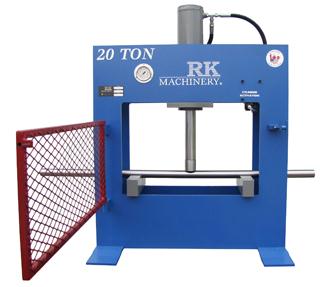Operating any machinery has its risks and safety concerns and shop presses are no exception. Ensuring safe handling and smart operation will minimize injuries and liabilities. More importantly investing in a
hydraulic press that meets the safety standards and requirements stipulated by the United States' safety regulatory body, Occupational Safety and Health Association (OSHA), will save you medical bills if not a life!
Consider these hydraulic press safety features as guidelines and tips:
Ram movement control
Most hydraulic presses are built with the operator's safety in mind. The fact that a machinist is able to adjust the ram speeds according to job specification by the use of ram movement controls makes shop presses better candidates for safe handling. Redundant solenoids help to control any ram movement that could be potentially hazardous. Keep in mind however, that even with these controls in place, if the operator has no knowledge of how to use them, this safety measure may be completely irrelevant!
Point of operation safety
With the built in light curtains and safety guards, a
standard shop press provides the operator with added safety precautionary measures to avoid accidental downward movement of the ram. When an undesired shadow (probably from an operator's body part or any other obstruction) is detected, the shop press automatically discontinues the ram travel speed and halts the operation giving the machinist a chance to make a split-second, life-saving decision! Light curtains are credited for their important job of keeping tabs on the loading and off-loading mechanism. Presence Sensing Device Initiating (PSDI) can also be used for added safety.
Installation of physical guards
Some hydraulic presses can be custom made to your safety specifications by adding physical safety guards and interlocks that ensure everything is in its place during the machining process. The main reason of adding physical guards is to provide a visible barrier between the machinist and the point-of-operation. This largely eliminates accidental loading and off-loading of the machine, especially in those shop presses that can be motion activated. Smart designs in today's shop press allow for in-built physical barriers that will not compromise visibility. Rather than using opaque material, transparent guards can be utilized. This offers the machinist much needed safety at the point of operation.
Work space and machine operation gear
Work space violations can be detrimental. Exposed electrical wires, loose and hanging pulleys or the lack of enough room to accommodate both the machine and the machinist could be a recipe for disaster! It is therefore wise to enhance safety by ensuring that you maintain an organized work space with minimal obstructions, if any, and adequate lighting. Keeping the floor clean and dry will also prevent slip and falls. Also using proper work gear is an added safety bonus.
Proper and updated in-service training
Every operator of a shop press needs periodic in-service training on how to safely handle the machine for maximum safety and minimum liabilities. Enlisting a professional service to deliver this training will be a smart idea. At the same time ensuring that your machines are checked for proper function and serviced if faulty will enhance production as well as operator safety.
 Français
Français
